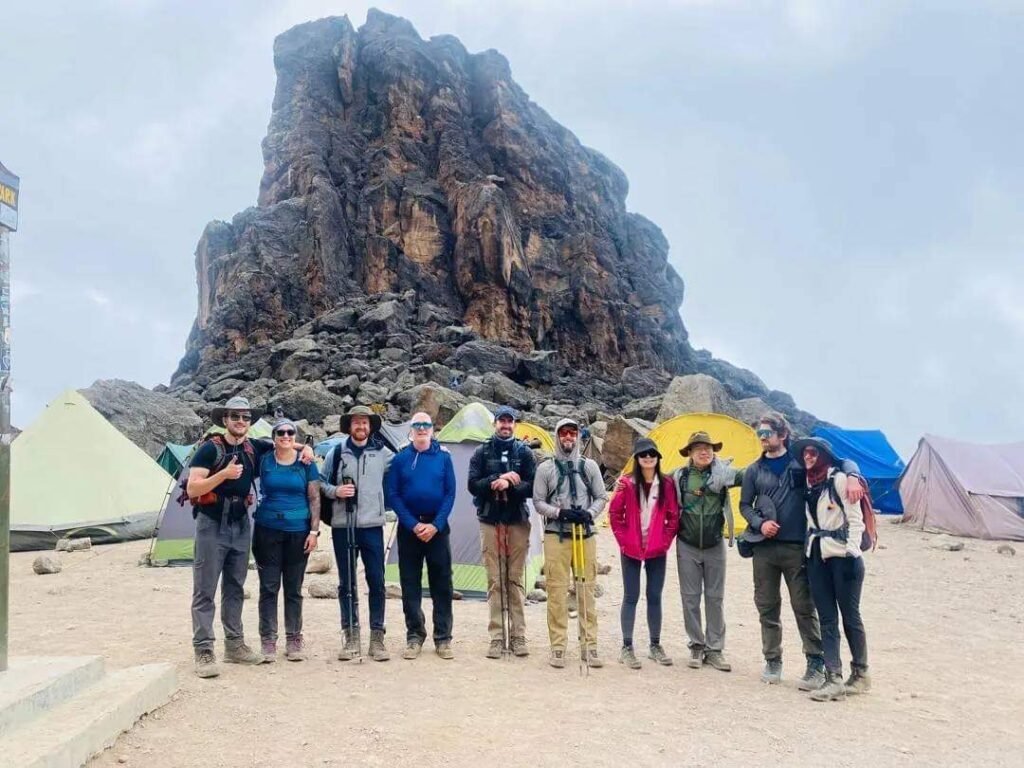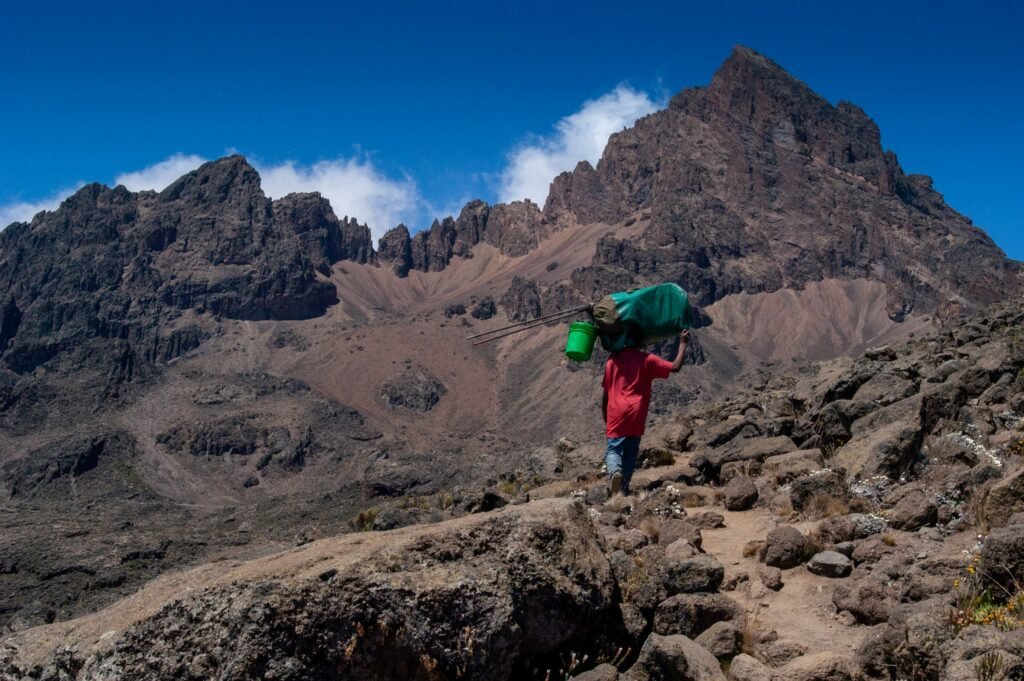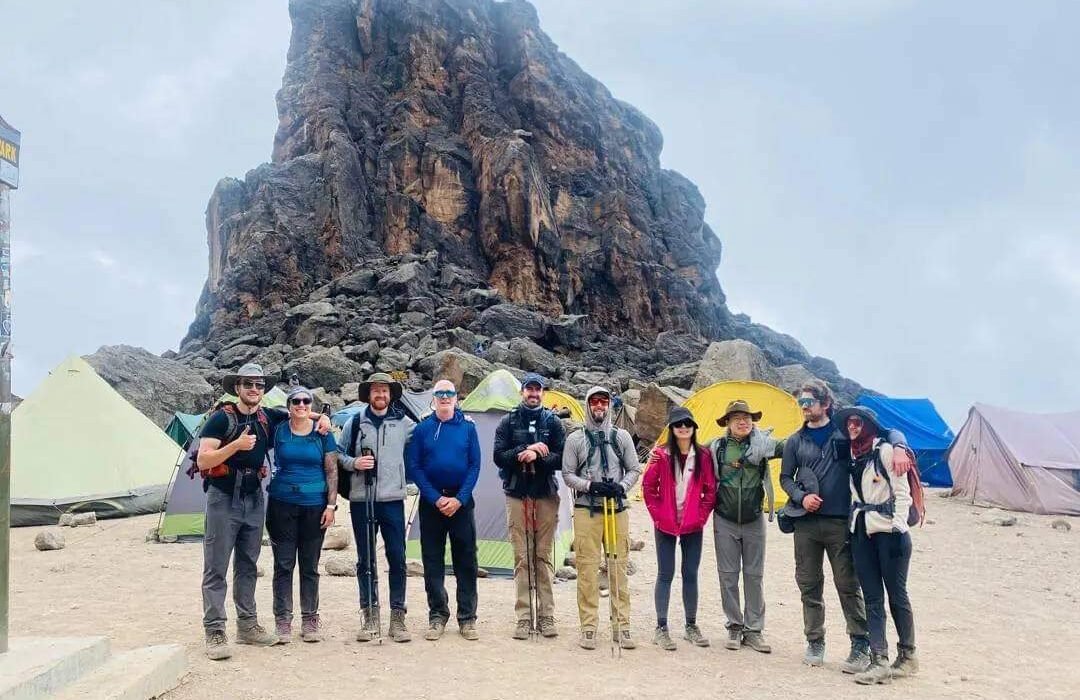Barranco Wall on Kilimanjaro : is one of the most talked-about sections of the climb, known for its challenging but non-technical ascent. Standing at an impressive 257 meters (843 feet), this steep rock face is part of the Machame, Lemosho, and Shira routes. Although the Barranco Wall may seem intimidating at first glance, it is a safe and achievable climb for those with a reasonable level of fitness and determination. Here’s everything you need to know about tackling the Barranco Wall on your journey to the summit of Kilimanjaro.
Plan your Kilimanjaro climb with expert guidance.

Barranco Wall on Kilimanjaro : What Is the Barranco Wall?
The Barranco Wall is a steep rock face that climbers must ascend on several of the most popular Kilimanjaro routes. It’s often referred to as a “scramble,” meaning that while it’s steep and hands may be used for support, it doesn’t require any technical climbing equipment. Climbers often find the challenge exhilarating, with rewarding views at the top.
- Location: The Barranco Wall is located on the southern side of Kilimanjaro, following a night at Barranco Camp.
Explore more about the route and its challenges.
2. Is the Barranco Wall Dangerous?
While the Barranco Wall may look daunting, it’s considered safe for climbers who follow their guide’s instructions. The climb involves a combination of hiking and scrambling, and there are sections where you’ll need to use your hands to navigate the rock. However, it’s important to note that no special climbing skills or equipment are required.
Safety Tips:
- Follow Your Guide: Kilimanjaro guides are experienced and know the safest routes up the wall.
- Go Slowly: As with much of Kilimanjaro, the key is to take your time and focus on each step.
- Listen to Your Body: Altitude can make the climb more tiring, so be sure to rest when needed.
Learn about safety measures for the Barranco Wall.
Barranco Wall on Kilimanjaro : What to Expect When Climbing the Barranco Wall
Climbers often approach the Barranco Wall with a mix of excitement and apprehension. While the wall may seem vertical from a distance, there are plenty of natural handholds and footholds that make the climb manageable. Most climbers will reach the top of the wall in 1-2 hours, depending on their pace.
Key Features of the Climb:
- Kissing Rock: One of the most famous spots on the Barranco Wall is a narrow section known as “Kissing Rock,” where climbers need to hug the rock face briefly to navigate the narrow path.
- Stunning Views: Once you reach the top, you’ll be rewarded with breathtaking views of the Karanga Valley and the summit of Kilimanjaro in the distance.
Get a detailed guide to climbing the Barranco Wall.
Barranco Wall on Kilimanjaro : How to Prepare for the Barranco Wall
To successfully tackle the Barranco Wall, climbers should focus on physical and mental preparation. While the climb itself isn’t technically difficult, it does require stamina and confidence. Here are some tips to help you prepare:
Training Tips:
- Practice Scrambling: If possible, practice scrambling or hiking on rocky terrain to build confidence.
- Build Upper Body Strength: Although the climb is mostly a hike, having some upper body strength can help you pull yourself up in places.
- Mental Preparation: The Barranco Wall can look intimidating, but stay calm and focus on the route ahead.
Learn how to train for Kilimanjaro’s physical challenges.
Barranco Wall on Kilimanjaro : What Happens After the Barranco Wall?
After reaching the top of the Barranco Wall, climbers often feel a sense of accomplishment. The hardest part of the day’s trek is behind you, but there is still more hiking ahead. You’ll descend slightly into the Karanga Valley before continuing towards the next camp.
- Rest and Recharge: The day after climbing the Barranco Wall is usually a shorter hike, giving climbers a chance to rest and recover before the final push to the summit.
Explore the next stages of the Kilimanjaro trek.
Barranco Wall on Kilimanjaro : Myths and Misconceptions About the Barranco Wall
Many climbers worry about the Barranco Wall before the trek even begins. While it’s certainly a challenging section of the climb, it’s not as dangerous or difficult as some rumors suggest. Here are a few common myths about the Barranco Wall:
Common Myths:
- It’s Too Steep: While the wall is steep, it’s not vertical, and there are plenty of safe places to rest and find footing.
- You Need Climbing Skills: No technical climbing skills are required. The climb is more like a hike with some scrambling.
- It’s the Most Dangerous Part of Kilimanjaro: While challenging, the Barranco Wall is not the most dangerous section of the mountain. The greatest risks on Kilimanjaro come from altitude sickness, not the terrain.
Debunk more myths about Kilimanjaro climbs.
Barranco Wall on Kilimanjaro : Tips for a Successful Barranco Wall Climb
The key to successfully climbing the Barranco Wall is preparation and patience. Here are a few final tips to help you tackle this exciting part of your Kilimanjaro experience:
- Take Your Time: Don’t rush the climb. Take it slow and steady, focusing on each step.
- Trust Your Guide: Your guide knows the safest and easiest path up the wall. Listen to their advice and follow their lead.
- Stay Hydrated: Make sure you’re drinking plenty of water to stay hydrated, especially as you continue to climb at higher altitudes.
Read more tips on preparing for Kilimanjaro.

Barranco Wall on Kilimanjaro : Conclusion
The Barranco Wall is a highlight of any Kilimanjaro climb. While it may seem intimidating, it’s a manageable and rewarding challenge that adds to the overall adventure of climbing Africa’s tallest mountain. By taking your time, following your guide’s advice, and preparing mentally and physically, you’ll be able to enjoy the stunning views and sense of accomplishment that come with reaching the top.
For expert guidance and personalized Kilimanjaro climbing packages, visit Kilimanjaro Climb Specialist or Eddy Tours & Safaris.

